(“See for yourself!”)
Many years ago a dear friend of ours called on the phone with a problem. She was Leigh Ferguson, probably the most prominent local dressage figure in the Rhode Island area at the time. She had been introduced to dressage back in the early 1960s when the Spanish Riding School had performed at the Boston Garden. Her future father in law, a fixture in Morgan horse circles, was doing a four in hand exhibition as part of the show, and through him she met Colonel Alois Podhajsky, the legendary head of the school. For some years as her dressage knowledge grew and until his death, Leigh maintained a wonderful correspondence with the Colonel.
Leigh’s early dressage successes were all on Morgans. Broadwall Felicity, her former saddle seat equitation horse, went all the way to Fourth Level, a feat rarely achieved in the US nearly fifty years ago. In the mid ‘70s Leigh competed on a quarter horse, but when the warmblood revolution struck on our side of the Atlantic, she went to Germany and through a friend found a four year old Hanoverian and brought him home.
This was 1980. I had known Leigh for some years. She’d let me ride her Morgan mare—the first horse I ever went sideways on (on purpose). She’d invited me to the Van Schaik clinics she arranged. I helped her teach her young QH to jump.
She had briefly ridden Waldgraf, her new warmblood, before she imported him, but when he arrived in the States, he turned out to be more than she’d bargained for. Immediately after she got on him, he hauled her across the paddock and proceeded to dump her in the dirt. Undaunted, she climbed back aboard, and he repeated his dismissal, leaving her on the ground and heading to the telephone to call me.
Back in those days I was doing lower level eventing on quite a variety of horses, and I had spent a year in Virginia riding all the young Trakehners at Chestnut Lawn Farm. “Could I please come and help her with him?”
I was pretty much a home-body back then, so driving several hours to get paid to ride a fancy horse was a big deal. And, of course, I could ride him because I was uninhibited by classical expectations—I just wanted the silly horse to go forward and behave.
We worked together through the summer, making some progress with him. Then, one September morning, another call: “He ran off with me on the trail and threw me again. I’m pretty banged up. AND I’m leaving to go to England for a month to give a dressage clinic. Will you take him while I’m gone?”
And so Waldgraf arrived . . . with a series of instructions and warnings: He can’t go on trails; Don’t gallop because he runs away; He won’t go through water; He’s too strong to be ridden by a woman.”
In my most reassuring bedside manner I replied, “Just have a good trip.” And set about to give lie to every one of her predictions.
As the month of training wound down, it was time for a test. At the time we lived above Boston on the North Shore near the New Hampshire border. There, above Cape Ann, is a most beautiful piece of real estate called Crane’s Beach. Overseen by the Trustees of Reservations, it is a totally undeveloped sandspit three or four miles long—ocean beach and dunes backed by a wide tidal estuary. In the summertime it draws crowds. In October it’s nearly deserted and horses are granted access to its pristine open spaces.
Not known for missing the opportunity to make a point, as Leigh was about to return, we took Waldgraf to the beach. And (remember this was pre-video 1980) we took a movie camera. Hi-jinks and merriment ensued.
was about to return, we took Waldgraf to the beach. And (remember this was pre-video 1980) we took a movie camera. Hi-jinks and merriment ensued.
When his owner asked how her horse had been, I handed her the three minute and twenty second, fifty foot reel of Super 8 film and said “See for yourself.”
[Below is a series of photos grabbed from the digital video which was converted from the VHS tape which was made from the original movie film which was taken that early November day in 1980]
The film begins with a closeup of Waldgraf’s feet as they move over the sand. Must be an outdoor arena. But the camera pulls back and pans evealing the ocean waves. We’re on the beach!
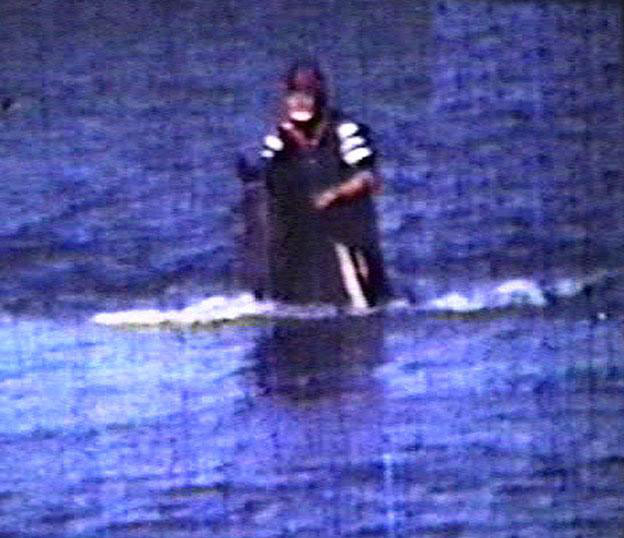 Unlike video, with only three-plus minutes of recording, you can’t keep the camera running. He has wavered and balked, approaching the water until each wavelet breaks and the foam rushes towards him. Then he backs away, only to step forward every time the water retreats. Finally, as though holding his nose in resignation, he has plunged towards Spain, bounding like a porpoise and unable to be turned until his feet can no longer touch bottom. Susan is laughing too hard to start the camera. Only when he’s swimming am I able to turn Waldgraf back towards the shore. This photo catches him wading in. The water temp is in the low 40s.
Unlike video, with only three-plus minutes of recording, you can’t keep the camera running. He has wavered and balked, approaching the water until each wavelet breaks and the foam rushes towards him. Then he backs away, only to step forward every time the water retreats. Finally, as though holding his nose in resignation, he has plunged towards Spain, bounding like a porpoise and unable to be turned until his feet can no longer touch bottom. Susan is laughing too hard to start the camera. Only when he’s swimming am I able to turn Waldgraf back towards the shore. This photo catches him wading in. The water temp is in the low 40s.
At low tide the beach slopes very gradually. In some places you can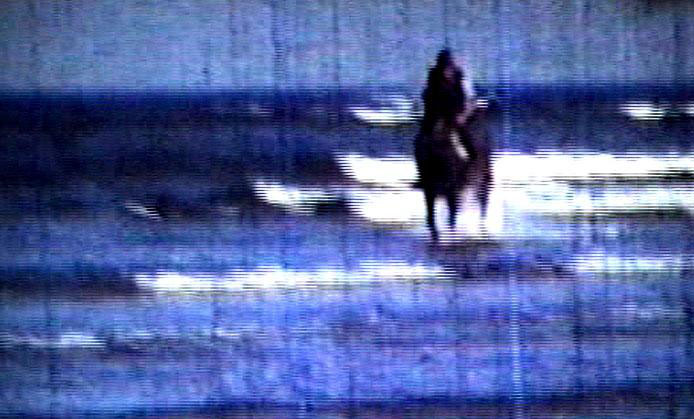 wade out more than half a mile among shallow pools and sandbars. He and I share the exuberance bestowed by nothing but sky, water, and sand!
wade out more than half a mile among shallow pools and sandbars. He and I share the exuberance bestowed by nothing but sky, water, and sand!
No, he’s not afraid of puddles.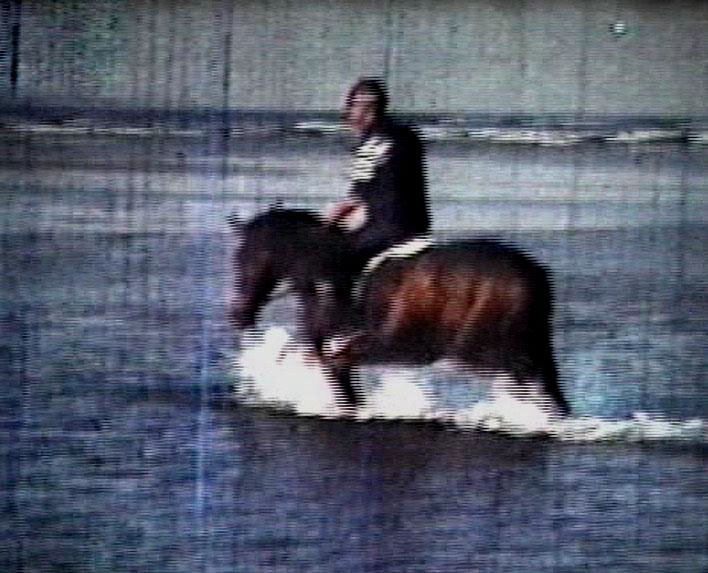
Yes, he can gallop and stop obediently.
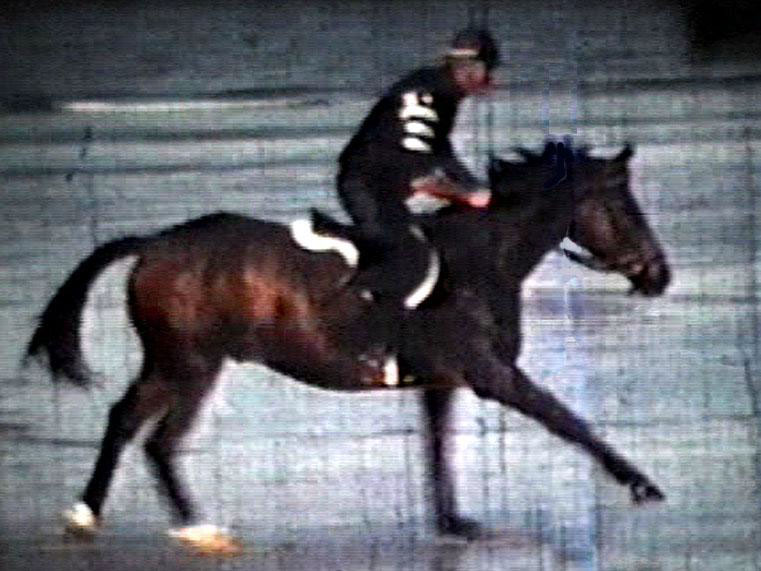
Yes, a woman can ride him.
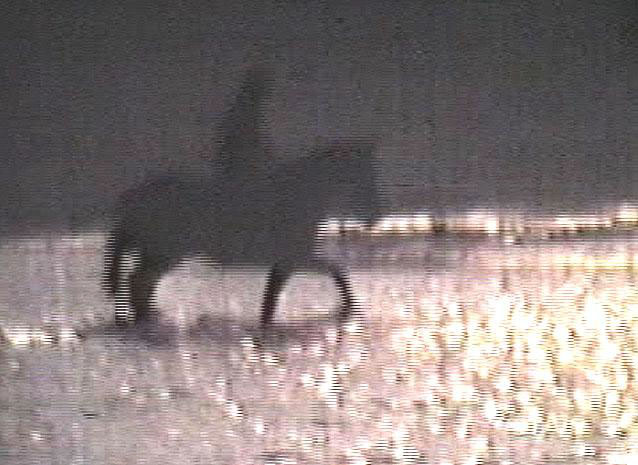
And, oh, by the way, here he is meeting a quahog.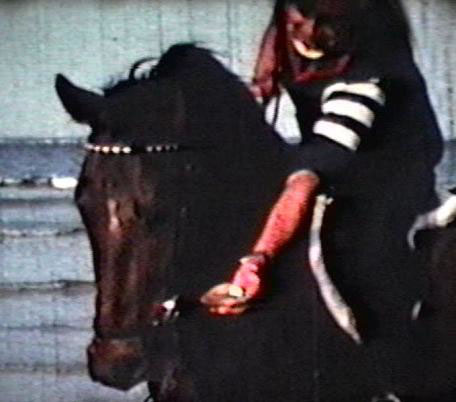
So in the long run, Leigh did decide to find a different horse. Waldgraf went through several hands. His training was advanced by Denny Callin and Elizabeth Madlener, and he made it all the way to Grand Prix, finishing third in the World Cup qualifier Finals at the Washington International in 1992 under Heidi Wilson, an unlikely but delightful ending for a horse who ran off and couldn’t go through puddles.
